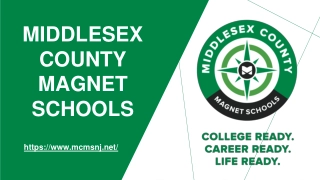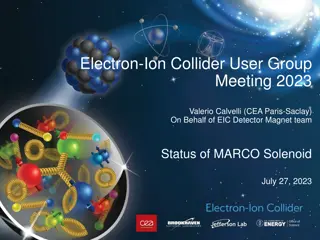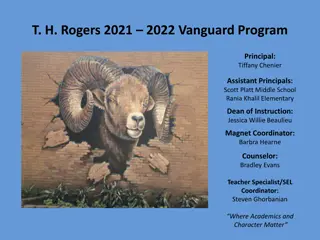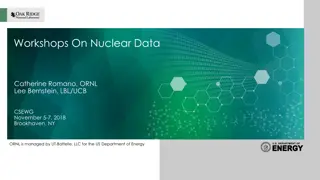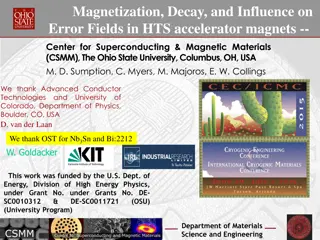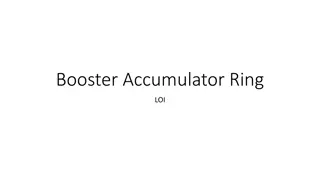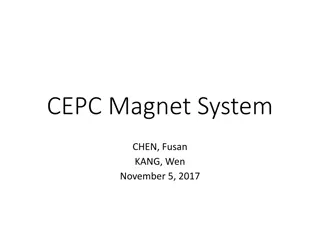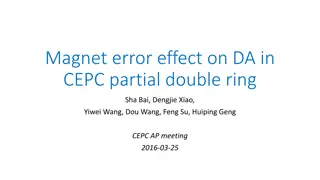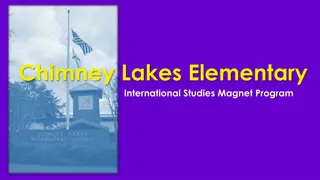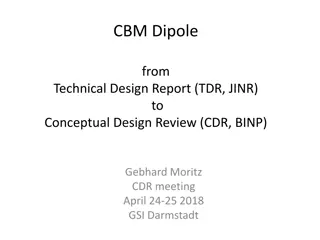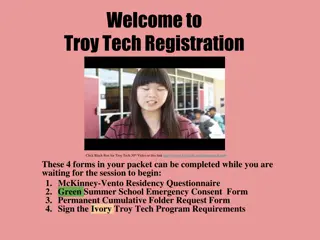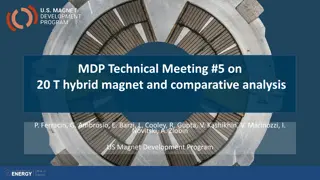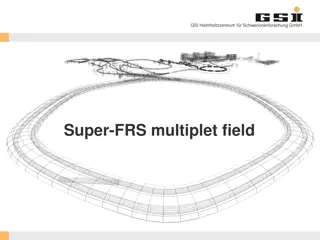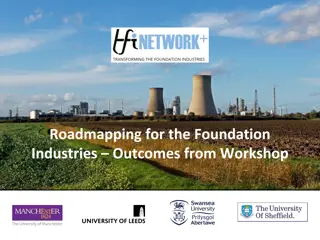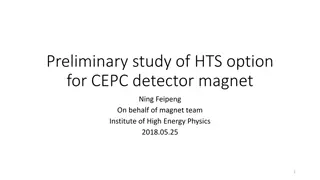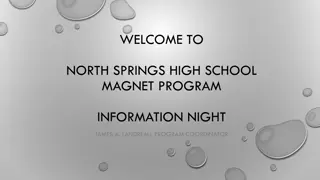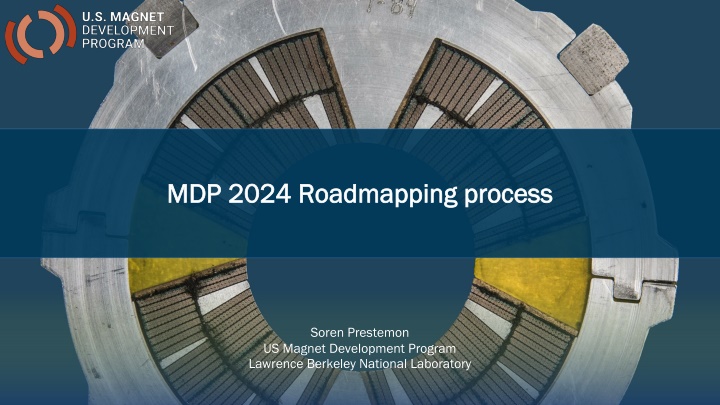
Roadmapping and Magnet Development Program Process
Finalizing new roadmaps for cable, coil, and magnet development. Coordinators' roles and responsibilities in organizing technical meetings, maintaining progress, and interacting with stakeholders. Incorporating new concepts and proposals for magnet designs within the program.
Uploaded on | 2 Views
Download Presentation

Please find below an Image/Link to download the presentation.
The content on the website is provided AS IS for your information and personal use only. It may not be sold, licensed, or shared on other websites without obtaining consent from the author. If you encounter any issues during the download, it is possible that the publisher has removed the file from their server.
You are allowed to download the files provided on this website for personal or commercial use, subject to the condition that they are used lawfully. All files are the property of their respective owners.
The content on the website is provided AS IS for your information and personal use only. It may not be sold, licensed, or shared on other websites without obtaining consent from the author.
E N D
Presentation Transcript
MDP 2024 MDP 2024 Roadmapping Roadmapping process process Soren Prestemon US Magnet Development Program Lawrence Berkeley National Laboratory
Finalizing our new roadmaps: process Cable & Coil Development & testing D. Davis Areas / sub-Areas identified Coordinators identified Research Thrusts and Milestones =>Under development Bi2212 inserts T. Shen REBCO inserts V. Kashikhin Nb3Sn SM Large Bore S. Zlobin & D. Arbelaez Area I: Hybrid accelerator magnets Area II: High field solenoids for HEP Magnet designs J.L. Rudeiros & K. Badgley Hybrid magnet integration P. Ferracin Magnet diagnostics & protection M. Marchevsky Performance analysis & enhancement S. Stoynev Advanced Modeling G. Vallone Materials & Conductors S. Krave, X. Xu Facility improvements R. Teyber CPRD I. Pong Area III: Next steps: - Areas meet, discuss, plan, propose - Coordinators communicate/iterate with G7 - Draft milestones shared in General Meeting - SP/G7 finalize plan in document Supporting technologies Higher T / All-HTS Sustainability Lance, Xiaorong IR & Combined function magnets G. Ambrosio [?] Interfacing with Collider Studies M. Palmer Area IV: Exploratory studies 4/30/2024 2
Coordinators: Roles and Responsibilities Organize Technical Meetings of the Area / sub-Area (https://conferences.lbl.gov/category/100/) o Draft meeting agenda o Set up Indico site for slides / documentation (help is available if needed) o Communicate progress of the Area at General Meetings Maintain progress towards milestones Interact with G7 on issues, concerns within the Area Coordinators are not asked to manage or direct all research in the Area - The role is coordination and communication, motivating team towards milestones coordination and communication, motivating team towards milestones - Develop a succession plan for future coordinators Note: Areas are encouraged to organize joint Technical Meetings rather than individual ones where appropriate 4/30/2024 3
Looking ahead: How we incorporate new concepts =>Process for reviews first draft * go/no-go Idea / proposal New magnet designs: New magnet designs: Proposals to explore via design and analysis: o low bar , i.e. we want to encourage ideas, innovate Proposal: no formal review no formal review, but communicate/agree with management Present results at a general meeting Proposals for prototyping: o higher bar due to need for resources and hardware Describe relevance and potential value to MDP Evaluate cost (effort and M&S) New addition to roadmap: o high bar needs to map well to program goals and strategy Need to understand cost and schedule (impacts existing program elements) Discuss in Area Discuss with local man. (G7 rep.)* Discussion by G7* Presentation at MDP General meeting Prepare review Review committee reports to G7 Magnets in the roadmap: Magnets in the roadmap: More akin to a project: preliminary design, prior to fabrication, prior to test, post-test Decision on support / next steps * 4/30/2024 4
Looking ahead: How we incorporate new concepts =>Process for reviews first draft * go/no-go Idea / proposal New directions/concepts in Supporting Technologies: New directions/concepts in Supporting Technologies: Proposals evaluated on alignment and impact on magnet deliverables: o Must address a magnet need, directly or indirectly o Should compare impact / value to elements already in the plan Need to identify quantifiable milestones and cost Discuss in Area Discuss with local man. (G7 rep.)* Discussion by G7* Presentation at MDP General meeting Evaluate cost, milestones Decision on support / next steps * 4/30/2024 5
Background 4/30/2024 6
Framing our process with driving questions These should be of a general nature o Guide us in developing a program roadmap for broad value o Pushing limits and innovating should be hallmarks of the program o Supports accelerator designs: Provide guidance on what is possible but we do not build to spec Clarify design aspects that drive cost, guide what is possible Our program should note distinctions between Hadron and Muon colliders 4/30/2024 7
The roadmap updates should enhance our efforts in HTS Build on the HTS developments to-date => get cables & magnets in high-field o Leverage and grow connections with NHMFL: Get HEP cables into background field fast feedback on performance Join forces to advance solenoid technology for HEP o Test HTS accelerator coils in hybrid magnet configuration Explore the potential of HTS o Opportunities/issues with higher T o Sustainability implications 4/30/2024 8
The magnet efforts build on a foundation of supporting elements we need to tighten the linkage These elements apply to all magnets o Is the list exhaustive? o Modifications/additions welcome! 4/30/2024 9
Areas where we can improve our collaboration Improve transparency: o What research elements/activities are being supported at each lab and to what level o Clarify who is involved and the expectations for collaborators o Clarify criteria and process for reviews Improve our documentation of lessons-learned o What has worked and what has not o Connect lessons-learned to update/adjust roadmap milestones Tighten the connection between supporting elements and magnets: o Diagnostics, modeling capabilities, magnet materials, etc. 4/30/2024 10
Our structure was revised with the 2020 Updated Roadmaps Area I: Nb3Sn magnets Coord.: Current Strategic Priorities: Sasha Zlobin & Diego Arbelaez "G7" Management Team Area II: HTS magnets Probing stress management structures LBNL: Soren Prestemon Steve Gourlay => Paolo Ferracin IIa: Bi23212 magnets Coord.: Tengming Shen FNAL: IIb: REBCO magnets Coord: Xiaorong Wang => Vadim Kashikhin Hybrid HTS/LTS designs Sasha Zlobin => Steve Gourlay George Velev BNL: Area III: Technology Understanding and impacting the disturbance- spectrum Kathleen Amm => Mark Palmer IIIa: Comparative analysis Coord.: Paolo Ferracin ASC/NHMFL: David Larbalestier Lance Cooley IIIb: Advanced modeling Coord: Lucas Brouwer => Giorgio Vallone Advancing both LTS and HTS conductors, optimized for HEP applications IIIc: Magnet materials Coord: Steve Krave Cond. Proc. and R&D (CPRD) Chair: Lance Cooley => Ian Pong IIId: Novel diagnostics Coord: Maxim Marchevsky IIIe: Training rate enhancement Coord. Stoyan Stoynev MDP 2024 Collaboration Meeting goals, charge and agenda - Soren Prestemon 4/30/2024 11
P5 identified 10 pTeV colliders for the energy frontier Colliders 10 pTeV energy frontier Higgs factories Hadron collider Muon collider SC Magnets for IRs, misc. Not a driver for magnet R&D These opportunities serve as drivers for magnet R&D MDP 2024 Collaboration Meeting goals, charge and agenda - Soren Prestemon 4/30/2024 12
The P5 recognized commonality in 10pTeV collider R&D Parallel to the R&D for a Higgs factory, the US R&D effort should develop a 10 TeV pCM collider, such as a muon collider, a proton collider, or possibly an electron-positron collider based on wakefield technology. The US should participate in the International Muon Collider Collaboration (IMCC) and take a leading role in defining a reference design. We note that there are many synergies between muon and proton colliders, especially in the area of development of high-field magnets. R&D efforts in the next 5-year timescale will define the scope of test facilities for later in the decade, paving the way for initiating demonstrator facilities within a 10-year timescale (Recommendation 6). Hadron collider magnet R&D Muon collider magnet R&D High field dipoles Sustainability MDP 2024 Collaboration Meeting goals, charge and agenda - Soren Prestemon 4/30/2024 13
US MDP 2020 roadmaps long range time for an update! Continue alignment with Continue alignment with physics community needs physics community needs Focus on stress Focus on stress- - management as well as management as well as hybrid HTS/LTS magnet hybrid HTS/LTS magnet technology technology Continue to invest in the Continue to invest in the science of magnets and science of magnets and in improved conductors in improved conductors MDP 2024 Collaboration Meeting goals, charge and agenda - Soren Prestemon 4/30/2024 14
Driving considerations in magnet R&D focus The Muon collider is the only collider with on-shore potential Both Muon and hadron colliders absolutely depend The Muon collider requires requires some use of HTS Both machines will be challenged by construction and operational costs challenged by construction and operational costs absolutely depend on magnet developments 1.Support vigorous R&D toward a cost-effective 10 TeV pCM collider based on proton, muon, or possible wakefield technologies, including an evaluation of options for US siting of such a machine, with a goal of being ready to build major test facilities and demonstrator facilities within the next 10 years As part of this initiative, we recommend targeted collider R&D to establish the feasibility of a 10 TeV pCM muon collider. A key milestone on this path is to design a muon collider demonstrator facility. Although we do not know if a muon collider is ultimately feasible, the road toward it leads from current Fermilab strengths and capabilities to a series of proton beam improve- ments and neutrino beam facilities, each producing world-class science while performing critical R&D towards a muon collider. At the end of the path is an unparalleled global facility on US soil. This is our Muon Shot. MDP 2024 Collaboration Meeting goals, charge and agenda - Soren Prestemon 4/30/2024 15
Sustainability is a major concern for future colliders Accelerator technologies play a key role in sustainability. Investments in high field magnets by the DOE Magnet Development Program and NSF s MagLab have advanced the state of the art in conductors and magnet design to the benefit of particle physics, but also materials science, fusion energy research (FES), and commercial development. In this context, high temperature superconducting materials, operated at temperatures higher than superfluid or liquid helium, can play a key role in reducing energy consumption e.g. for future colliders including muons or FCC-hh. This roadmap relies on the design and construction of accelerators and detectors at the forefront of particle physics. The technology choices for achieving the Higgs factory and 10 TeV pCM collider goals need to be determined based on technical feasibility, cost- effectiveness, host site capacity, sustainability, and synergies with the demands of other science topics. Other new technologies such as muon and possibly wakefield colliders have potential to improve power required for a given luminosity and reduce the size and impact of future facilities. Innovation in electric power generation, management and distribution also contribute to sustainable development and shall be encouraged. MDP 2024 Collaboration Meeting goals, charge and agenda - Soren Prestemon 4/30/2024 16
Cost is a driving, and likely decisive, factor in a future collider The panel recommends dedicated R&D to explore a suite of promising future projects. One of the most ambitious is a future collider concept: a 10 TeV parton center-of-mo- mentum (pCM) collider to search for direct evidence and quantum imprints of new physics at unprecedented energies. Turning this concept into a cost-effective, realistic collider design demands that we aggressively develop multiple innovative accelerator and detector technologies. This process will establish whether a proton, electron, or muon accelerator is the optimal path to our goal. We do not yet have a technology capable of building a 10 TeV pCM energy machine, but the case for one is clear. Extensive R&D is required to develop cost-effective options. Possibilities include proton beams with high-field magnets, muon beams that require rapid capture and acceleration of muons within their short lifetime, and conceivably electron and positron beams with wakefield acceleration. The technology choices for achieving the Higgs factory and 10 TeV pCM collider goals need to be determined based on technical feasibility, cost-effectiveness, host site capacity, sustainability, and synergies with the demands of other science topics. MDP 2024 Collaboration Meeting goals, charge and agenda - Soren Prestemon 4/30/2024 17
Recap of our MDP vision and goals Maintain and strengthen US Leadership in high-field accelerator magnet technology for future colliders Focus on the four primary goals identified in the the original MDP Plan o Explore the performance limits of Nb3Sn accelerator magnets, with a focus on minimizing the required operating margin and significantly reducing or eliminating training o Develop and demonstrate an HTS accelerator magnet with a self-field of 5T or greater, compatible with operation in a hybrid HTS/LTS magnet for fields beyond 16T o Investigate fundamental aspects of magnet design and technology that can lead to substantial performance improvements and magnet cost reduction o Pursue Nb3Sn and HTS conductor R&D with clear targets to increase performance and reduce the cost of accelerator magnets Further develop and integrate the teams across the partner laboratories and Universities for maximum value and effectiveness to the program Identify and nurture cross-cutting / synergistic activities with other programs to more rapidly advance progress towards our goals MDP 2024 Collaboration Meeting goals, charge and agenda - Soren Prestemon 4/30/2024 18
Our Program was initiated as a result of the 2013 P5 report Strategic priorities for the current plan: o Probing stress management structures o Hybrid HTS/LTS designs o Understanding and impacting the disturbance-spectrum o Advancing both LTS and HTS conductors, optimized for HEP applications Message from last MDP CM: Need to increase focus on hybrid magnets - Intrinsically connects the core program priorities MDP 2024 Collaboration Meeting goals, charge and agenda - Soren Prestemon 4/30/2024 19

